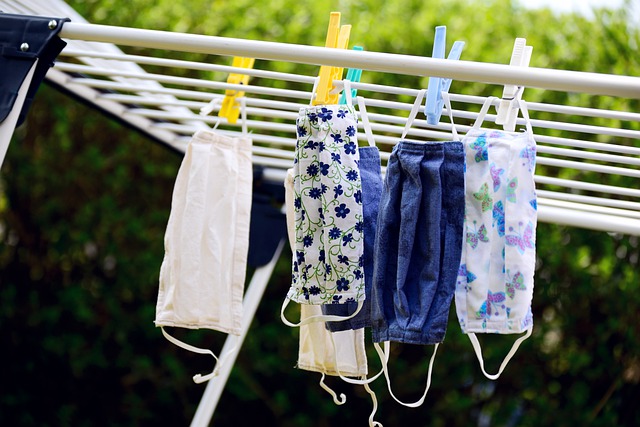In a press conference on 10 August, Senior Defence Minister, Ismail Sabri Yaakob, posed an interesting question: “As long as the face is covered, like the nose and mouth, those who wear the purdah, for example – do they still need to wear a mask? What about selendang or head coverings in certain states that can be used to cover the face, is that okay?”
He also asked the Health Ministry to study if face shields, or even the purdah, are sufficient to prevent coronavirus infection.
There was an outbreak of several Covid-19 cases among staff and guests at a hotel in Switzerland. Health officials found that only people who wore plastic face shields got infected. Those who wore a mask, or a combination, did not. They concluded that face shields did not protect people but masks did.
Face shields can offer an added layer of protection, but should be used in addition to a mask, social distancing, and handwashing, NOT as a substitute.
CDC does not currently (7 Aug) recommend the use of face shields as a substitute for masks. “A face shield is primarily used for eye protection for the wearer. At this time, it is not known what level of protection a face shield provides to people nearby from the spray of respiratory droplets from the wearer. There is currently not enough evidence to support the effectiveness of face shields for source control”.
Face shields are used in health care, e.g. intubation, dental or surgical procedures, where tissue fragments, blood or bodily fluids could get into the health care worker’s eyes, nose and mouth. The curved plastic or Plexiglas panel attached to a headband should fit securely so there is no gap between the band and the forehead. The shield should wrap around the sides of the wearer’s face and extend beyond the chin.
The hearing impaired or developmentally challenged who need to lip-read and those who interact with them may prefer face shields to masks, but see-through face masks are safer options e.g. FDA-registered, UV-C sterilizable, fully transparent face mask made from medical grade silicone.
Swiss scientists have developed a fully transparent surgical mask (“HelloMask”) to be mass produced soon.
Are face shields effective?
A 2014 study showed that face shields can substantially reduce the short-term exposure of health care workers to large infectious aerosol particles, but smaller particles can remain airborne longer and flow around the face shield more easily.
Wearing a face shield reduced the inhalational exposure by 96% immediately after a cough. It also reduced the surface contamination of a respirator by 97%.
However, the face shield was less effective with smaller cough aerosols, blocking only 68% inhalation and 76% of the surface contamination. In the period from 1 to 30 minutes after a cough, during which the aerosol had dispersed throughout the room and larger particles had settled, the face shield reduced aerosol inhalation by only 23%.
Thus, face shields provide a useful adjunct to respiratory protection for workers caring for patients with respiratory infections, but should not be used without masks.
Face shield wearers should:-
- Wash hands before and after removing the face shield.
- Avoid touching eyes, nose and mouth when removing it.
- Clean and disinfect reusable face shields after each use according to manufacturer instructions (CDC face shield cleaning instructions).
- Wear and dispose single use disposable face shield according to manufacturer instructions.
How to keep a face shield clean
Unlike masks, face shields do not absorb droplets when the wearer speaks, sneezes or coughs. They need to be sanitised frequently. Coronavirus persists longer on plastic than on porous materials like cloth, paper or cardboard.
The face shield should be cleaned once it is taken off and can be sanitised with antibacterial wipe, alcohol pad or soap and water. Cracked or damaged shields should be discarded.
Plastic face shields are NOT recommended for newborns and infants.
Face shields alone not good for everyday protection
CDC does not recommend wearing face shields for normal everyday activities or as a substitute for cloth face coverings. Some people may choose to use a face shield when they are in sustained close contact with others (e.g. in classroom).
In these cases, it is best to wear a mask underneath the face shield and maintain physical distancing when possible. This will help minimise the risk of infection since face shields have openings at the bottom and to the sides.
CDC recommends that people wear masks in public settings and when around people who do not live in their household, especially when other social distancing measures are difficult to maintain.
- Masks help prevent people with Covid-19 from spreading the virus to others.
- Masks, when widely used in public, may reduce the spread of Covid-19.
- Masks should NOT be worn by children under the age of 2 or anyone who has trouble breathing, is unconscious, incapacitated, or otherwise unable to remove the mask without assistance.
- Masks with exhalation valves or vents do not prevent the infectious person wearing the mask from spreading Covid-19 to others (good for personal protection but not good for source control).
In a 14 July editorial in the Journal of the American Medical Association, CDC reviewed the latest science and affirms “that cloth face coverings are a critical tool in the fight against Covid-19 that could reduce the spread of the disease, particularly when used universally within communities. There is increasing evidence that cloth face coverings help prevent people who have Covid-19 from spreading the virus to others.”
Does it matter what sort of mask you wear? Yes!
Different types of mask offer different levels of protection. N95 respirators offer the highest level of protection, followed by surgical masks. These masks are costly, in limited supply, are uncomfortable to wear for prolonged periods, and contribute to landfill non-biodegradable waste.
Such masks (especially N95) should be reserved for health workers, front-liners and high-risk groups (elderly, obese etc).
Analysis by the Royal Society found that face masks (including DIY cloth ones) when worn properly, contribute to reducing transmission of Covid-19 based on:
(1) the incidence of asymptomatic and pre-symptomatic transmission,
(2) the role of respiratory droplets in transmission, which can travel 1-2 metres,
(3) studies of the use of homemade and surgical masks to reduce droplet spread.
Their use could reduce onward transmission by asymptomatic and pre-symptomatic wearers if widely used in situations where physical distancing is not possible or predictable.
Household transmission of SARS-CoV-2 can be reduced by using masks in the home, as shown by research published online May 28 in BMJ Global Health.
In households in which family members wore masks at home before the first person became ill, there was less likelihood of transmission of disease to other family members, compared with families in which no one wore a mask prior to illness onset.
N95 > Surgical Mask > Double-Layer Cloth Mask > Single-Layer Fabric?
One US study investigated which household materials best removed particles of 0.3-1.0 microns in diameter, the typical size of viruses and bacteria, and concluded that good options included vacuum cleaner bags, heavyweight cotton used for quilting or multiple layers of material. Scarves and bandanna material were less effective, but still captured a fraction of particles.
CDC suggested that any covering, including a bandanna, is better than none. This view was recently challenged by Duke University physics professor Martin Fischer. Fischer built a simple box out of cardboard with an opening for a person wearing a mask to speak into.
He attached a green laser light to the box to illuminate the droplets and a cell phone camera to video the experiments, so they could count the droplets each mask allowed through.
This inexpensive, accessible device provided visual proof that masks do block droplets. He confirmed that speaking did produce plenty of droplets, and that the material used in some masks, especially the neck gaiters and bandannas they tested, were so thin it actually put more respiratory particles in the air than the baseline test with no mask at all.
Fischer said: “We attribute this to the fleece, the textile, breaking up those big particles into many little particles, which tend to hang around longer in the air and get carried away further. So it might actually be counterproductive to wear such a mask.
“So it is not the case that any mask is better than nothing.”
Martin Fischer, Duke University physics professor
“We confirmed that when people speak, small droplets get expelled, so disease can be spread by talking, without coughing or sneezing. Some face coverings performed much better than others in blocking expelled particles. If everyone wore a mask, we could stop up to 99% of these droplets before they reach someone else.”
Which Material Works Best For DIY Homemade Cloth Mask?
Researchers at Cambridge University tested a wide range of household materials for homemade masks. To measure effectiveness, they shot Bacillus atrophaeus bacteria (0.93-1.25 microns) and Bacteriophage MS virus (0.023 microns – smaller than coronavirus) at different household materials.
On average, the homemade masks captured 7% fewer virus particles than the larger bacteria particles. However, all materials managed to capture 50% of virus particles or more (except scarf at 49%), surgical mask 89%, vacuum filter 86%, dish towel 73%, cotton blend 70%, antimicrobial pillowcase 68%, linen 62%, pillow case 57%, silk 54%, 100%-cotton T-shirt 51%.
A study on the Aerosol Filtration Efficiency of Common Fabrics Used in Respiratory Cloth Masks confirmed that when a single layer was used, the efficiency ranged from 5% to 80% and 5% to 95% for particle sizes of <300 nm and >300 nm respectively.
This improved when multiple layers were used and when using a specific combination of different fabrics. Filtration efficiencies of the hybrids (such as cotton–silk, cotton–chiffon, cotton–flannel) was >80% for particles <300 nm and >90% for particles >300 nm.
The researchers speculated that the enhanced performance of the hybrids was likely due to the combined effect of mechanical and electrostatic-based filtration. Cotton performs better at higher weave densities (higher thread count) and can make a significant difference in filtration efficiencies when used in hybrids.
Bottom Line: The Best Materials for DIY Face Masks
- Best choices are cotton T-shirts, pillowcases, or other cotton material (highest thread count preferred).
- Hybrid layers (cotton-silk, cotton-chiffon, cotton-flannel) seem to filter better.
- Scarves (selendang) are less effective depending on the material and layering. Bandannas or purdahs may break up air droplets into finer particles, so may not be good for source control (i.e. protecting others).
The legal definition of what constitutes a “face mask” must first be established before hefty fines are imposed on those found without. Arbitrariness will lead to accusations of discrimination and loopholes for corrupt practice.

A fusion opinion from a Sarawakian public health specialist, paediatrician, ex-associate professor, disaster relief and medical volunteer, passionate about helping people learn.
- This is the personal opinion of the writer or publication and does not necessarily represent the views of CodeBlue.








